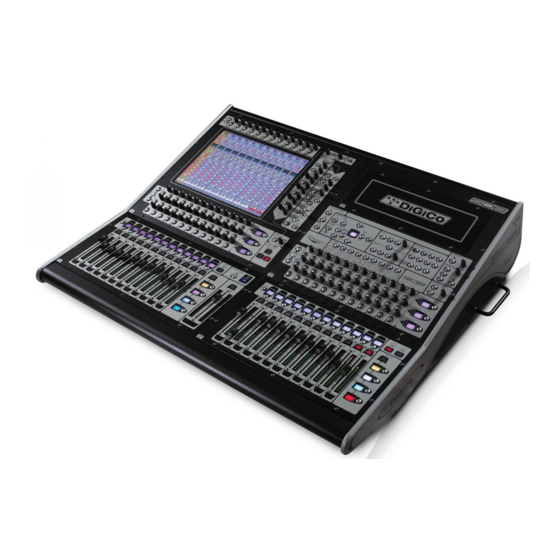digico SD10 Benutzerhandbuch - Seite 11
Blättern Sie online oder laden Sie pdf Benutzerhandbuch für Aufnahmegeräte digico SD10 herunter. digico SD10 20 Seiten. Replacing and cleaning faders
Auch für digico SD10: Handbuch (9 seiten)

1.1 Introduction
The Digico SD10 consists of a worksurface with an onboard audio engine and a range of onboard inputs and outputs. This can be
connected to multiple Input/Output Rack Units by MADI links or optical fibre (optionally) which carry all the audio input and output
signals.
The console worksurface consists of 3 sections that can control 96 input channels (12 of which can be stereo with no loss of
channel count), 12 VCAs, up to 48 aux/group busses (plus Master buss configurable as LCR, and solo buss), a matrix of 16
inputs and 12 outputs, 24 onboard graphic EQs and 10 onboard stereo effects.
The left section has 12 assignable faders and 12 sets of assignable encoders and switches.
The centre section has, a touchscreen, 12 assigned encoders, 12 assignable faders, 12 sets of assignable encoders and
switches, a full set of channel processing controls and a master fader.
The right section has 12 assignable faders, 12 sets of assignable encoders and switches and controls for monitoring, head-
phones, talkback, macros and snapshots.
Any of these worksurface sections can be assigned to the centre touchscreen.
Multiple console setups can provide:
Front of House and Monitoring with shared stage racks and gain tracking.
Remote control of a console from a laptop computer.
Optional extras include Waves plug-ins and Broadcast mode (Broadcast mode includes features such as surround busses, mix
minus busses, multi-input channels, backstop PFL, auto PFL, fader start GPOs and expanded monitoring options). See the Appen-
dices for details of these options.
1.2 Manual Overview
-
Chapter 1 provides an overview of the desk, and describes some of the basic operating principles which the user
will need to understand in order to run the desk.
-
Chapter 2 describes the functions of the different channel types.
-
Chapter 3 describes the master section of the desk, focusing on the various menus in the Master screen.
-
Chapter 4 describes network, mirroring and multi-console setups
-
Chapter 5 is a guide to troubleshooting
-
Appendices are provided for the Waves plug-ins, Broadcast mode options, and Optocore operation.
The following typographical conventions are used in this manual:
Bold type is used to indicate that the text is an exact copy of the labelling either on a screen or on the worksurface.
An arrow bracket (>) is used to indicate a sequence of button pressing. For example, Layout > Fader Banks indicates that the
Fader Banks button is accessed by first pressing the Layout button.
Chapter 1 - Getting Started
1-3
